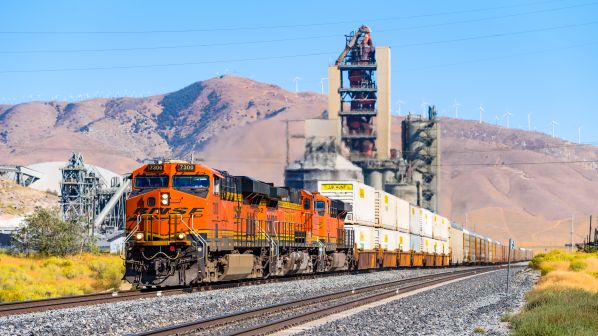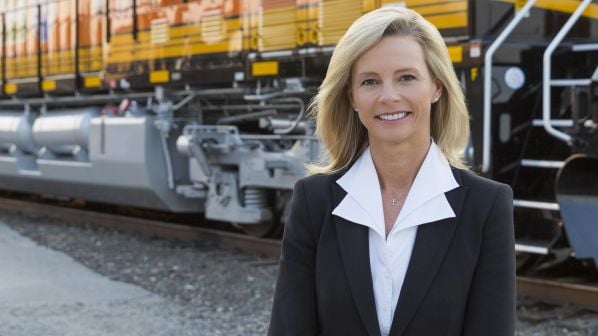Farmer has held leadership positions in every major function of BNSF, starting as a management trainee at predecessor Burlington Northern in 1992. She takes over from Mr Carl Ice, who is retiring, and will lead the board of directors while overseeing the 52,300 route-km network that spans 28 states and three Canadian provinces for parent company Berkshire Hathaway.
Farmer’s priorities include driving productivity and delivering a high level of customer service; improving communication across the railway and ensuring that connections continue to be made with all parties it affects; and supporting employees to reach their full potential by taking advantage of similar professional development opportunities she was afforded.
Farmer joined Burlington Northern on an internship between her junior and senior year of college at Texas Christian University.
“What attracted me to the rail industry back then and what’s true today is the importance of what the rail industry does and the relevancy,” Farmer told IRJ’s sister publication Railway Age on October 8. “The railroad is really the backbone of the United States economy, and I liked that aspect. Through the pandemic, we have seen that with great clarity. BNSF has delivered critical PPE [personal protective equipment] to the front lines; we’ve helped restock the shelves. We make a difference, and that’s because of our employees - the hard-working men and women at BNSF.”
The US has been hit hard by the Covid-19 pandemic. Farmer says that in the depths of the first wave of the pandemic, BNSF was loading around 150,000 units a week, down from pre-pandemic levels of more than 200,000 units a week. This had recovered to around the 200,000 units mark in early October.
BNSF’s consumer products business, including domestic and international intermodal and automotive sectors, were key in driving the recovery.
“We have seen volume increase quickly,” Farmer says. “Over-the-road [long-distance] capacity has tightened. There is a restocking going on in the supply chain, so we are helping to refill the distribution centres.
“Something that we were seeing in this country before the pandemic was the move from bricks-and-mortar to online retailing; we have seen that accelerate as we’ve moved through the pandemic. We’re excited about that. We think that is a great fit for our railroad. We have the largest intermodal network in the world - the fastest, most consistent network - and that’s a great match for what our customers need.
“When you have a competitive cost structure and a focus on growth, you have a great opportunity to have a return that justifies investment in capacity.”
Katie Farmer, BNSF president and CEO
“Working closely with the large retailers, the steamship companies, the trucking companies, we believe that’s going to be a great mutual opportunity. Parcel shipments, truckload shipments, anything in our consumer products business will continue to be strong through the balance of the year.”
Farmer says this growth hasn’t been replicated in other sectors such as the industrial products business, which has seen slower, more gradual increases.
Freight linked with energy production, including sand for fracking, was struggling to recover following the pandemic, while freight related to the construction industry was increasing more steadily. The agricultural commodities sector was least hit by the pandemic.
BNSF had witnessed a structural decline in coal volumes prior to the pandemic, Farmer says, with a mild winter resulting in reduced demand for electricity and low natural gas prices.
“Those volumes have stabilised now coming out of the pandemic, but they were certainly impacted by the shutdown,” she says.
Operating philosophy
While other Class I railways have streamlined operations under Precision Scheduled Railroading (PSR), BNSF has bucked the trend. As a subsidiary of Berkshire Hathaway, BNSF is in a unique position compared with the other North American Class 1s which have to respond to the whims of shareholders.
“We are tied very closely to the industrial and consumer economies, and if you look back over time, there have been peaks and valleys in volumes,” Farmer says. “What we believe at BNSF is we have to have a bias for growth. That means we position ourselves to be flexible enough that when we have opportunities for growth, we capture them. To do that, you have to have a competitive cost structure. So we have a relentless focus on efficiency, productivity, and having that competitive cost structure.
“When you have a competitive cost structure and a focus on growth, you have a great opportunity to have a return that justifies investment in capacity. And when you invest in capacity, it positions you to be able to say ‘yes’ to customers. That’s our business model.”
Farmer says BNSF is looking to invest in places that enable the railway to continue to respond to customer needs and improve efficiency and productivity.
“When you invest in capacity, it positions you to be able to say ‘yes’ to customers. That’s our business model.”
Katie Farmer
“That’s our long-term perspective,” she says. “In the short-term, we have to work to match our resources with demand - our locomotives, our track, our terminal capacity, our workforce.
Farmer says BNSF has consistently committed to investing in the integrity of its infrastructure, including when volumes were lower. This continued in 2020, when about $US 2.4bn of BNSF’s $US 3bn capital plan was spent on infrastructure.
“The challenge for us is when we look at projects, we can’t look at capital on a one-year timeline; we have to look at it with more of a five to 10-year lens,” Farmer says. “Even in a period like this year where volumes are lower, we’re involved in multi-year expansion projects. We think it’s the right thing to do - again, to position ourselves to be able to say ‘yes’ in the future for customers.”
Farmer points to the opening of a fourth mainline in Winslow, Arizona, along the Southern Transcon corridor between Southern California and Chicago, Illinois, last year as an example of how BNSF is using infrastructure to improve services for customers by increasing the consistency and efficiency of operation.
“The value is that Winslow is a crew-change point on our Southern Transcon,” Farmer says. “It allows us to be able to handle different profiles of freight, meaning we can handle grain trains and high-speed intermodal trains, all through the terminal, and make crew-changes and do inspections without impacting the velocity for any of our customers. Why we’re particularly excited is we now have that kind of capability at every one of our crew-change locations across the Southern Transcon.”

BNSF is also anticipating growth in the parcel, truckload and international businesses, and will continue to invest in preparation for this upturn. This includes a multi-year project to add an additional 80km of second track to the Southern Transcon corridor from Kansas City to Wellington, Kansas, taking the entire corridor to 99% double-track.
“This project will not only give us extra capacity, but it will give us additional recoverability in our network, so when we have service interruptions, this gives us more capabilities to run around interruptions and deliver the kind of service that our customers require,” Farmer says.
However, BNSF is not looking to increase its locomotive fleet, with Farmer saying it was appropriately sized to meet growing customer demand.
Technology
Improved infrastructure performance is aided by the deployment of new technologies. For example, BNSF is using machine vision systems (MVS) with its network of wayside detectors to reduce rail equipment incidents and service interruptions. The technology uses artificial intelligence (AI) in combination with MVS to analyse equipment images and identify small defects before they lead to larger problems.
The system collects 750,000 images a day. If the AI detects an issue, it sends an alarm to a mechanical desk in BNSF’s network operations centre that is manned 24/7. Mechanical employees then diagnose the issue and decide whether to stop the train immediately or let it carry on to its destination.
“We are going to continue to look at where we can roll that out across our system for additional equipment components,” Farmer says. “But as great as the data and artificial intelligence is, it takes really good people to understand what to do with it. And I think that’s important because you get a lot of data, and what we need is our talented people who know how to railroad and know what to do with the information to really make an impact and make it actionable.”
While the recovery from the Covid-19 pandemic will be an immediate challenge for Farmer in 2021, she acknowledges there will be ups and downs in future as she aims to shape the legacy of BNSF for the next 25 years.
“I look forward to continuing to lead us through the various business cycles to continue to drive productivity and efficiency and a good cost structure, and most importantly, to deliver the kind of service that our customers have come to expect from BNSF,” she says.
This feature is based on a Rail Group on Air podcast, available at railjournal.com, Apple podcasts, Google Play and Soundcloud.

